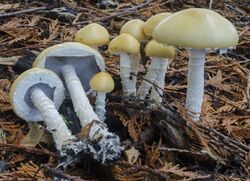Biology:Stropharia ambigua
| Stropharia ambigua | |
|---|---|

| |
| Scientific classification | |
| Domain: | Eukaryota |
| Kingdom: | Fungi |
| Division: | Basidiomycota |
| Class: | Agaricomycetes |
| Order: | Agaricales |
| Family: | Strophariaceae |
| Genus: | Stropharia |
| Species: | S. ambigua
|
| Binomial name | |
| Stropharia ambigua (Peck) Zeller (1914)
| |
| Synonyms | |
| |
| Stropharia ambigua | |
|---|---|
| Mycological characteristics | |
| gills on hymenium | |
| cap is convex | |
| hymenium is adnate | |
| stipe has a ring | |
| spore print is purple-brown | |
| ecology is saprotrophic | |
| edibility: unknown | |
Stropharia ambigua, sometimes known as the questionable Stropharia, is a saprotrophic agaric mushroom, commonly fruiting in leaf litter and wood chips in the Pacific Northwest.[1]
Description
The cap is 3 to 15 cm (1 1⁄8 to 5 7⁄8 in) broad, obtuse to convex, becoming flat or uplifted in age; it has a smooth surface, is slimy when moist, and yellowish.[2] The edge may have bits of white veil hanging from it.[1] The flesh is white, thick, and soft. The gills are pale gray and gradually darkens to purplish-gray or purplish-black.[2] The gills occasionally pull away from the stipe with age.[3] The stipe is 6 to 18 cm (2 3⁄8 to 7 1⁄8 in) long, 1–2 cm wide[4] and is stuffed or hollow. It may have bits of white veil hanging from it and, less commonly, a brittle ring.[1] The veil is soft and white. The spore print is dark purplish to nearly black. The species fruits in the spring and fall.[2] It does not have a volva.[3] The species has been said to taste like old leaves.[5]
Edibility
Alexander Hanchett Smith and Nancy S. Weber state that the species is not poisonous.[2] Contrarily, one source regards it as possibly poisonous.[6] Because of conflicting reports on its edibility, the authors David Arora, Orson K. Miller, Jr. and Hope Miller do not recommend eating the species.[3][7]
Distribution and habitat
Stropharia ambigua appears in late fall as a solitary to scattered mushroom or in groups on rich humus, usually under conifers. It can also be found with alder and other hardwoods in the Pacific Coast.[5] It has frequently been found in disturbed areas, such as where wood was handled.[2] The species will colonize outdoor mushroom beds after wood chips have been decomposed by a primary saprotroph.[8] It favors a cold and damp environment.[3]
Similar species
Similar species include Stropharia aeruginosa, S. coronilla,[4] S. riparia,[1] and S. semiglobata.[4]
References
- ↑ 1.0 1.1 1.2 1.3 Trudell, Steve; Ammirati, Joe (2009). Mushrooms of the Pacific Northwest. Timber Press Field Guides. Portland, OR: Timber Press. pp. 210-211. ISBN 978-0-88192-935-5. https://books.google.com/books?id=WevHvt6Tr8kC.
- ↑ 2.0 2.1 2.2 2.3 2.4 Smith, Alexander Hanchett; Weber, Nancy S. (1980). The Mushroom Hunter's Field Guide. University of Michigan Press. pp. 225-226. ISBN 978-0-472-85610-7. https://books.google.com/books?id=TYI4f6fqrfkC&pg=PA225.
- ↑ 3.0 3.1 3.2 3.3 Arora, David (1991). All That the Rain Promises and More: A Hip Pocket Guide to Western Mushrooms. Ten Speed Press. pp. 126. ISBN 978-0-89815-388-0. https://books.google.com/books?id=87ct90d4B9gC&pg=PA126.
- ↑ 4.0 4.1 4.2 Davis, R. Michael; Sommer, Robert; Menge, John A. (2012). Field Guide to Mushrooms of Western North America. Berkeley: University of California Press. pp. 216-217. ISBN 978-0-520-95360-4. OCLC 797915861. https://www.worldcat.org/oclc/797915861.
- ↑ 5.0 5.1 Arora, David (1986). Mushrooms Demystified: A Comprehensive Guide to the Fleshy Fungi. Ten Speed Press. p. 378. ISBN 978-0-89815-169-5. https://archive.org/details/mushroomsdemysti00aror_0.
- ↑ Multiple authors, Fuller Thomas C.; McClintock, Elizabeth May (1986). Poisonous Plants of California. University of California Press. p. 53. ISBN 978-0-520-05569-8. https://books.google.com/books?id=GDpCNKm7xTQC&pg=PA53.
- ↑ K. Miller, Orson; Miller, Hope (2006). North American Mushrooms: A Field Guide to Edible and Inedible Fungi. Globe Pequot. p. 256. ISBN 978-0-7627-3109-1. https://books.google.com/books?id=zjvXkLpqsEgC&pg=PA256.
- ↑ Stamets, Paul (2000). Growing gourmet and medicinal mushrooms. Ten Speed Press. p. 12. ISBN 978-1-58008-175-7. https://books.google.com/books?id=y1fnacRg1AYC&pg=PA12.
External links
Wikidata ☰ Q7624795 entry
 |

